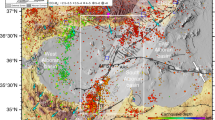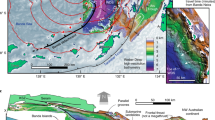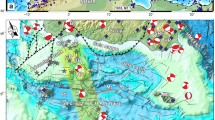Abstract
Historical accounts describe an earthquake and tsunami on 21 July AD 365 that destroyed cities and drowned thousands of people in coastal regions from the Nile Delta to modern-day Dubrovnik. The location and tectonic setting of this earthquake have been uncertain until now. Here, we present evidence from radiocarbon data and field observations that western Crete was lifted above sea level, by up to 10 m, synchronously with the AD 365 earthquake. The distribution of uplift, combined with observations of present-day seismicity, suggest that this earthquake occurred not on the subduction interface beneath Crete, but on a fault dipping at about 30∘ within the overriding plate. Calculations of tsunami propagation show that the uplift of the sea floor associated with such an earthquake would have generated a damaging tsunami through much of the eastern Mediterranean. Measurement of the present rate of crustal shortening near Crete yields an estimate of ∼5,000 yr for the repeat time of tsunamigenic events on this single fault in western Crete, but if the same process takes place along the entire Hellenic subduction zone, such events may occur approximately once every 800 yr.
This is a preview of subscription content, access via your institution
Access options
Subscribe to this journal
Receive 12 print issues and online access
$259.00 per year
only $21.58 per issue
Buy this article
- Purchase on Springer Link
- Instant access to full article PDF
Prices may be subject to local taxes which are calculated during checkout





Similar content being viewed by others
References
Ambraseys, N. N., Melville, C. P. & Adams, R. D. The Seismicity of Egypt, Arabia and the Red Sea: A Historical Review (Cambridge Univ. Press, Cambridge, 1994).
Elias, A. et al. Active thrusting offshore Mount Lebanon: Source of the tsunamigenic AD 551 Beirut-Tripoli earthquake. Geology 35, 755–758 (2007).
Salamon, A., Rockwell, T., Ward, S. N., Guidoboni, E. & Comastri, A. Tsunami hazard evaluation of the Eastern Mediterranean: Historical analysis and selected modeling. Bull. Seismol. Soc. Am. 97, 705–724 (2007).
Jackson, J. & McKenzie, D. The relationship between plate motions and seismic moment tensors, and rates of active deformation in the Mediterranean and Middle East. Geophys. J+ 93, 45–73 (1988).
Spratt, T. A. B. Travels and Researches in Crete Vol. 2 (J. van Voorst, London, 1865).
Pirazzoli, P. A., Thommeret, J., Thommeret, Y., Laborel, J. & Montaggioni, L. F. Crustal block movements from Holocene shorelines: Crete and Antikithera (Greece). Tectonophysics 86, 27–43 (1982).
Pirazzoli, P. A., Ausseil-Badie, J., Giresse, P., Hadjidaki, E. & Arnold, M. Historical environmental changes at Phalasarna harbour, West Crete. Geoarcheology 7, 371–392 (1992).
Pirazzoli, P. A., Laborel, J. & Stiros, S. C. Earthquake clustering in the Eastern Mediterranean during historical times. J. Geophys. Res. 101, 6083–6097 (1996).
Papazachos, B. C. Large seismic faults in the Hellenic arc. Ann. Geofis. 39, 891–903 (1996).
England, P. & Molnar, P. Surface uplift, uplift of rocks, and exhumation of rocks. Geology 18, 1173–1177 (1990).
Thommeret, Y., Thommeret, J., Laborel, J., Montaggioni, L. F. & Pirazzoli, P. A. Late Holocene shoreline changes and seismo-tectonic displacements in western Crete (Greece). Z. Geomorphol. 40, 127–149 (1981).
Price, S., Higham, T., Nixon, L. & Moody, J. Relative sea-level changes: reassessment of radiocarbon dates from Sphakia and west Crete. Annual—British School at Athens 97, 171–200 (2002).
Taymaz, T., Jackson, J. & Westaway, R. Earthquake mechanisms in the Hellenic Trench near Crete. Geophys J. Int. 102, 695–731 (1990).
Mascle, J. & Chaumillon, E. An overview of Mediterranean Ridge collisional accretionary complex as deduced from multichannel seismic data. Geo-Mar. Lett. 18, 81–89 (1998).
Okada, Y. Internal deformation due to shear and tensile faults in a half space. Bull. Seismol. Soc. Am. 82, 1018–1040 (1992).
De Chabalier, J. B. et al. A detailed analysis of microearthquakes in western Crete from digital three-component seismograms. Geophys. J. Int. 110, 347–360 (1992).
Meier, T., Rische, M., Endrun, B., Vafidis, A. & Harjes, H.-P. Seismicity of the Hellenic subduction zone in the area of western and central Crete observed by temporary local seismic networks. Tectonophysics 383, 149–169 (2004).
Tichelaar, B. W. & Ruff, L. J. Depth of seismic coupling along subduction zones. J. Geophys. Res. 98, 2017–2038 (1993).
Pirazzoli, P. A. The early Byzantine tectonic paroxysm. Z. Geomorphol. 62, 31–49 (1986).
Stiros, S. C. & Drakos, A. A fault model for the tsunami-associated, magnitude ≥8.5 Eastern Mediterranean, AD 365 earthquake. Z. Geomorphol. 146, 125–137 (2006).
Wang, R., Lorenzo-Martin, F. & Roth, F. PSGRN/PSCMP-a new code for calculating co- and post-seismic deformation, geoid and gravity changes based on the viscoelastic-gravitational dislocation theory. Comput. Geosci. 32, 527–541 (2006).
Scholz, C. H, Aviles, C. A. & Wesnousky, S. G. Scaling differences between large interplate and intraplate earthquakes. Bull. Seismol. Soc. Am. 76, 65–70 (1986).
Subarya, C. et al. Plate-boundary deformation associated with the great Sumatra-Andaman earthquake. Nature 440, 46–51 (2006).
Bilham, R. & England, P. Plateau pop-up in the great 1897 Assam earthquake. Nature 410, 806–809 (2001).
Gower, J. Jason 1 detects the 26 December 2004 tsunami. EOS trans. AGU 86, 37–38 (2005).
Park, J.-O., Tsuru, T., Kodaira, S., Cummins, P. R. & Kaneda, Y. Splay fault branching along the Nankai subduction zone. Science 297, 1157–1160 (2002).
Moore, G. F. et al. Three-dimensional splay fault geometry and implications for tsunami generation. Science 318, 1128–1131 (2007).
Plafker, G. Tectonic deformation associated with the 1964 Alaska earthquake. Science 148, 1675–1687 (1965).
Ichinose, G., Somerville, P., Thio, H. K., Graves, R. & O’Connell, D. Rupture process of the 1964 Prince William Sound, Alaska, earthquake from the combined inversion of seismic, tsunami, and geodetic data. J. Geophys. Res. 112, B07306 (2007).
Le Pichon, X. & Angelier, J. The Aegean Sea. Phil. Trans. R. Soc. A 300, 357–372 (1981).
Endrun, B, Meier, T., Bischoff, M. & Harjes, H.-P. Lithospheric structure in the area of Crete constrained by receiver functions and dispersion analysis of Rayleigh phase velocities. Geophys. J. Int. 158, 592–608 (2004).
Siddall, M. et al. Sea-level fluctuations during the last glacial cycle. Nature 423, 853–858 (2003).
Hamouda, A. Z. Numerical computations of 1303 tsunamigenic propagation towards Alexandria, Egyptian Coast. J. Afr. Earth Sci. 44, 37–44 (2006).
Bronk Ramsey, C. Radiocarbon calibration and analysis of stratigraphy: The OxCal program. Radiocarbon 37, 425–430 (1995).
Bronk Ramsey, C. & Hedges, R. E. M. Hybrid ion sources: Radiocarbon measurements from microgram to milligram. Nucl. Instrum. Methods B 123, 539–545 (1997).
Bronk Ramsey, C., Pettitt, P. B., Hedges, R. E. M., Hodgins, G. W. L. & Owen, D. C. Radiocarbon dates from the Oxford AMS system: Archaeometry Datelist 29. Archaeometry 42, 243–254 (2000).
Bronk Ramsey, C., Higham, T. F. G. & Leach, P. Towards high precision AMS: Progress and limitations. Radiocarbon 46, 17–24 (2004).
Hughen, K. A. et al. Marine04 marine radiocarbon age calibration, 0–26 cal kyr BP. Radiocarbon 46, 1059–1086 (2004).
Reimer, P. J. & McCormac, F. G. Marine radiocarbon reservoir corrections for the Mediterranean and Aegean Seas. Radiocarbon 44, 159–166 (2002).
Hughen, K., Southon, J., Lehman, S., Bertrand, C. & Turnbull, J. Marine-derived 14C calibration and activity record for the past 50,000 years updated from the Cariaco Basin. Quat. Sci. Rev. 25, 3216–3227 (2006).
Ford, R. et al. A nonhydrostatic finite-element model for three-dimensional stratified oceanic flows. Part I: Model formulation. Mon. Weath. Rev 132, 2816–2831 (2004).
Gorman, G. J. et al. Optimal bathymetric representation through constrained unstructured mesh adaptivity. Ocean Modell. 12, 436–452 (2006).
Fischer, K. D. & Babeyko, A. Modelling the 365 AD Crete earthquake and its tsunami. Geophys. Res. Abs. 9, 09458 (2007).
Herring, T. A., King, R. W. & McClusky, S. C. GAMIT Reference Manual: GPS Analysis at MIT, Release 10.3 (Department of Earth, Atmospheric, and Planetary Sciences, Massachussetts Institute of Technology, Cambridge, 2006).
Altamimi, Z., Collilieux, X., Legrand, J., Garayt, B. & Boucher, C. ITRF2007: A new release of the International Terrestrial Reference Frame based on time series of station positions and Earth Orientation Parameters. J. Geophys. Res. 112, B09401 (2007).
Herring, T. A., King, R. W. & McClusky, S. C. GLOBK Reference Manual: Global Kalman Filter VLBI and GPS Analysis Program, Release 10.3 (Department of Earth, Atmospheric, and Planetary Sciences, Massachussetts Institute of Technology, Cambridge, 2006).
Reilinger, R. et al. GPS constraints on continental deformation in the Africa-Arabia-Eurasia continental collisional zone and implications for the dynamics of plate interactions. J. Geophys. Res. 111, B05411 (2006).
Engdahl, E. R., Van der Hilst, R. D. & Buland, R. P. Global teleseismic earthquake relocation with improved travel times and procedures for depth determination. Bull. Seismol. Soc. Am. 88, 722–743 (1998).
Jost, M. L., Knabenbauer, O., Cheng, J. & Harjes, H.-P. Fault plane solutions of microearthquakes and small events in the Hellenic arc. Tectonophysics 356, 87–114 (2002).
Hatzfeld, D., Besnard, M., Makropoulos, K. & Hatzidimitriou, P. Microearthquake seismicity and fault-plane solutions in the southern Aegean and its geodynamic implications. Geophys. J. Int. 115, 799–818 (1993).
Acknowledgements
This work was supported by NERC, through grant NER/A/S/2001/01607 to P.C.E., and to COMET. M.D.P., G.J.G. and C.C.P. acknowledge the support of NERC under grants NE/C51829X/1 and NE/C52101X/1. We are indebted to H. Billiris, D. Paradisis and C. Raptakis for their support in the establishment and maintenance of the continuous GPS network whose results we use here, and to N. Forrest and M. Ziebart for many helpful discussions about processing continuous GPS data. We thank D. Hatzfeld for providing microearthquake data. We thank M. Brasier, N. Charnley, J. Darrell, O. Green, B. Rosen, P. Taylor, A. Thomas and the staff of the Oxford Radiocarbon Accelerator Unit, for their help in obtaining 14C dates, with species identification and with sample preparation and imaging. We thank D. Ham for advice on computational modelling. We are grateful to R. Bilham, S. Lamb and P. Molnar for comments that improved the manuscript.
Author information
Authors and Affiliations
Contributions
N.N.A., P.C.E., J.A.J. and B.S. were involved in project planning. P.C.E., T.F.G.H., J.A.J. and B.S. carried out the field work and sampling. G.J.G., C.C.P. and M.D.P. are responsible for the tsunami modelling, and M.A.F. and J.-M.N. carried out the GPS analysis. T.F.G.H. is responsible for the radiocarbon dating. N.N.A. researched historical references to the earthquake.
Corresponding author
Supplementary information
Supplementary Information
Supplementary figures 1 and 2 (PDF 2070 kb)
Supplementary Information
Supplementary video S2 (AVI 1545 kb)
Supplementary Information
Supplementary video S3 (AVI 3450 kb)
Supplementary Information
Supplementary video S4 (AVI 1501 kb)
Supplementary Information
Supplementary video S5 (AVI 3372 kb)
Rights and permissions
About this article
Cite this article
Shaw, B., Ambraseys, N., England, P. et al. Eastern Mediterranean tectonics and tsunami hazard inferred from the AD 365 earthquake. Nature Geosci 1, 268–276 (2008). https://doi.org/10.1038/ngeo151
Received:
Accepted:
Published:
Issue Date:
DOI: https://doi.org/10.1038/ngeo151
This article is cited by
-
Probabilistic Tsunami Risk Assessment from Incomplete and Uncertain Historical Impact Records: Mediterranean and Connected Seas
Pure and Applied Geophysics (2023)
-
Deterministic tsunamigenic earthquake hazard assessment for the northern coast of Egypt based on multi-scenario approach
Mediterranean Geoscience Reviews (2023)
-
Recognizing megatsunamis in Mediterranean deep sea sediments based on the massive deposits of the 365 CE Crete event
Scientific Reports (2022)
-
Risk Assessment of Tsunamis Along the Chinese Coast Due to Earthquakes
International Journal of Disaster Risk Science (2022)
-
Source modeling and spectral analysis of the Crete tsunami of 2nd May 2020 along the Hellenic Subduction Zone, offshore Greece
Earth, Planets and Space (2021)



